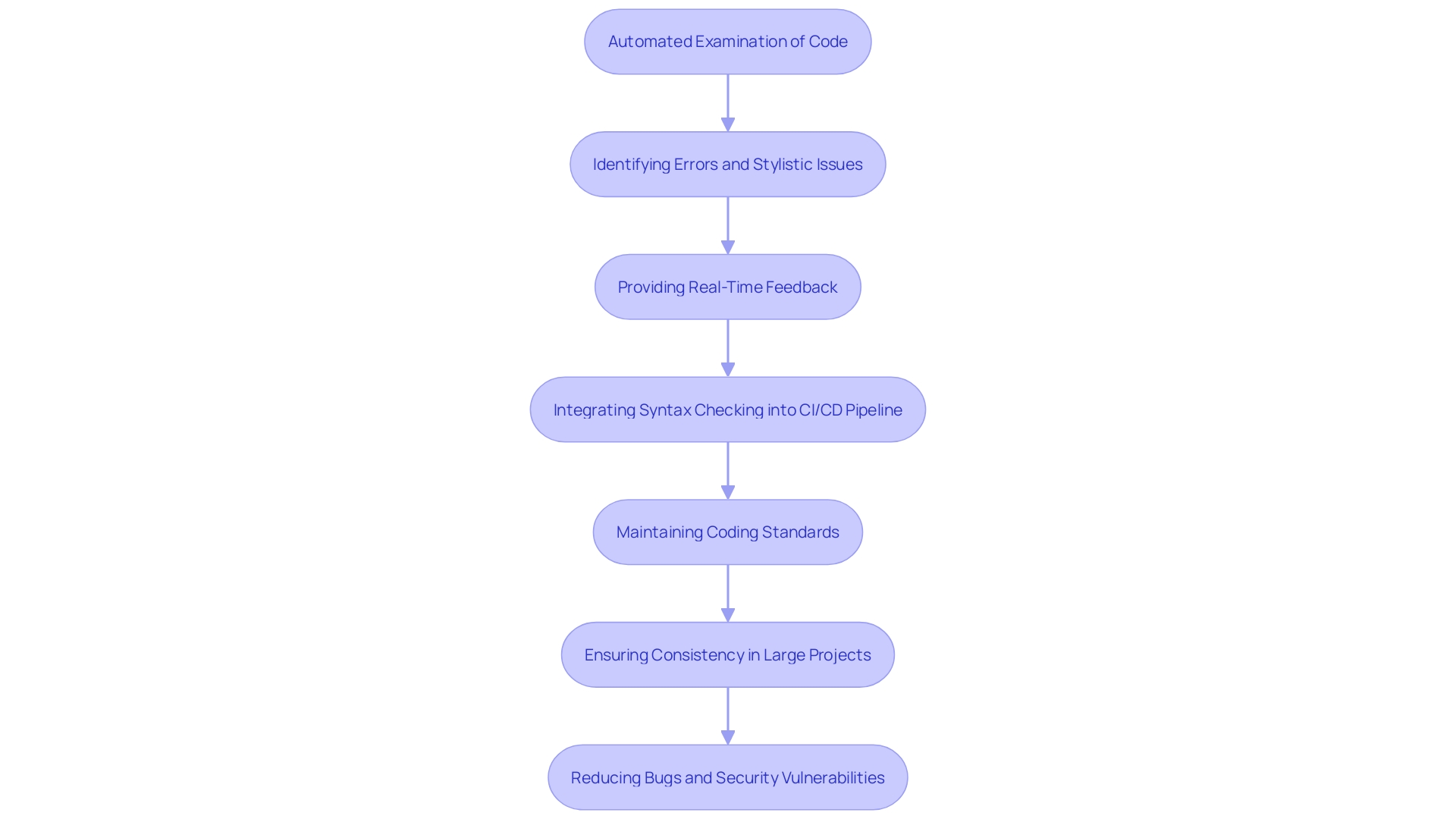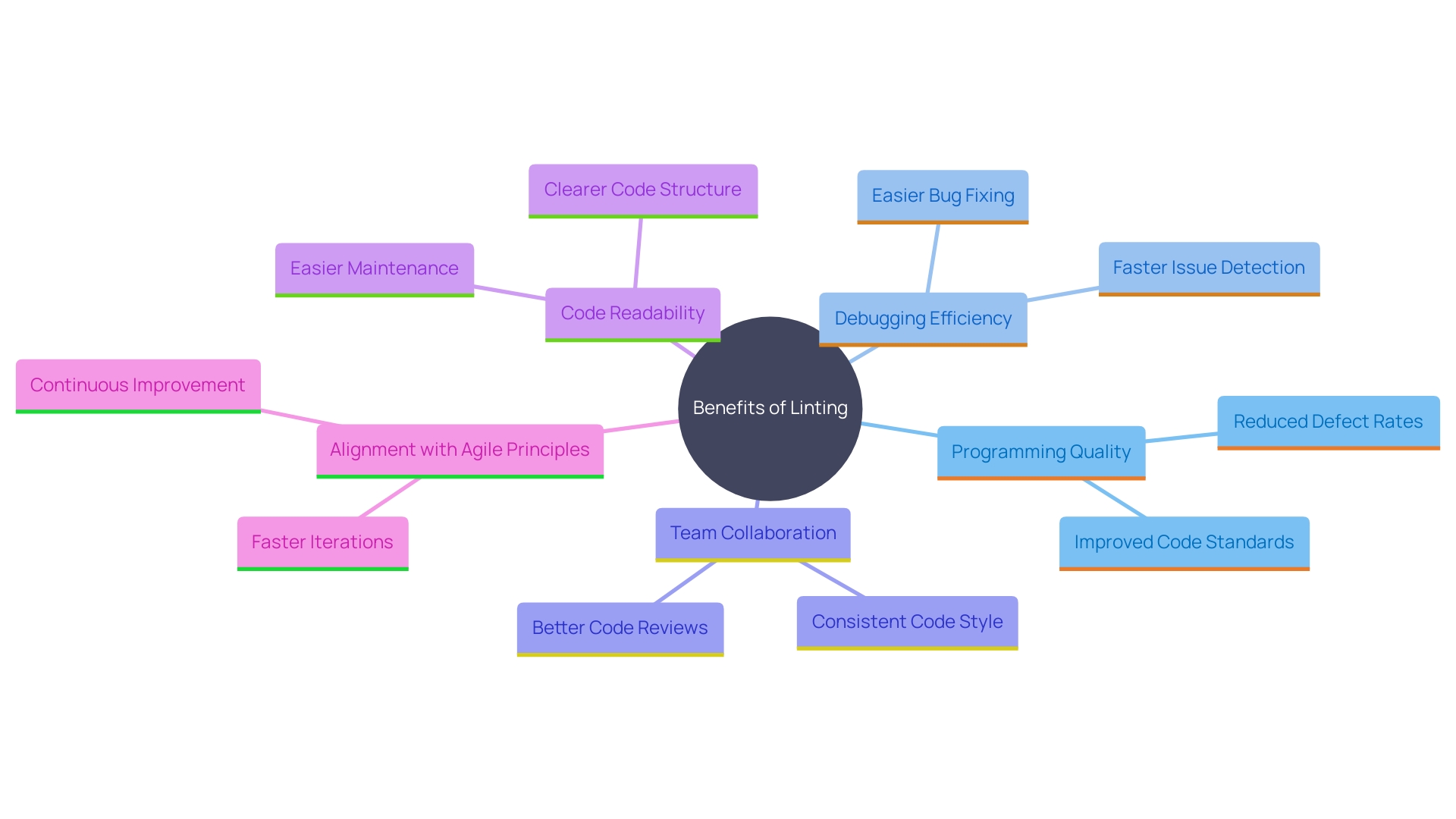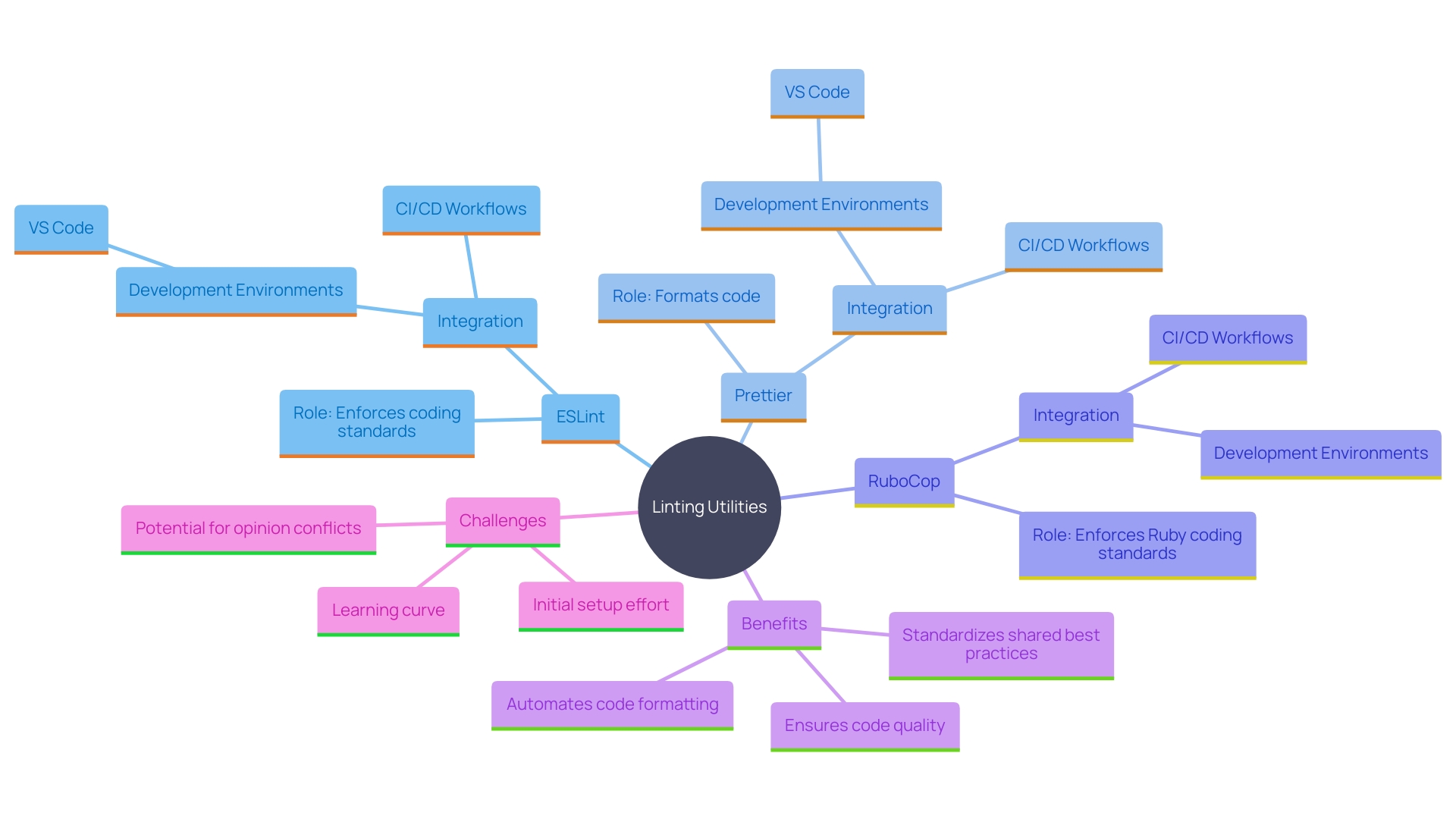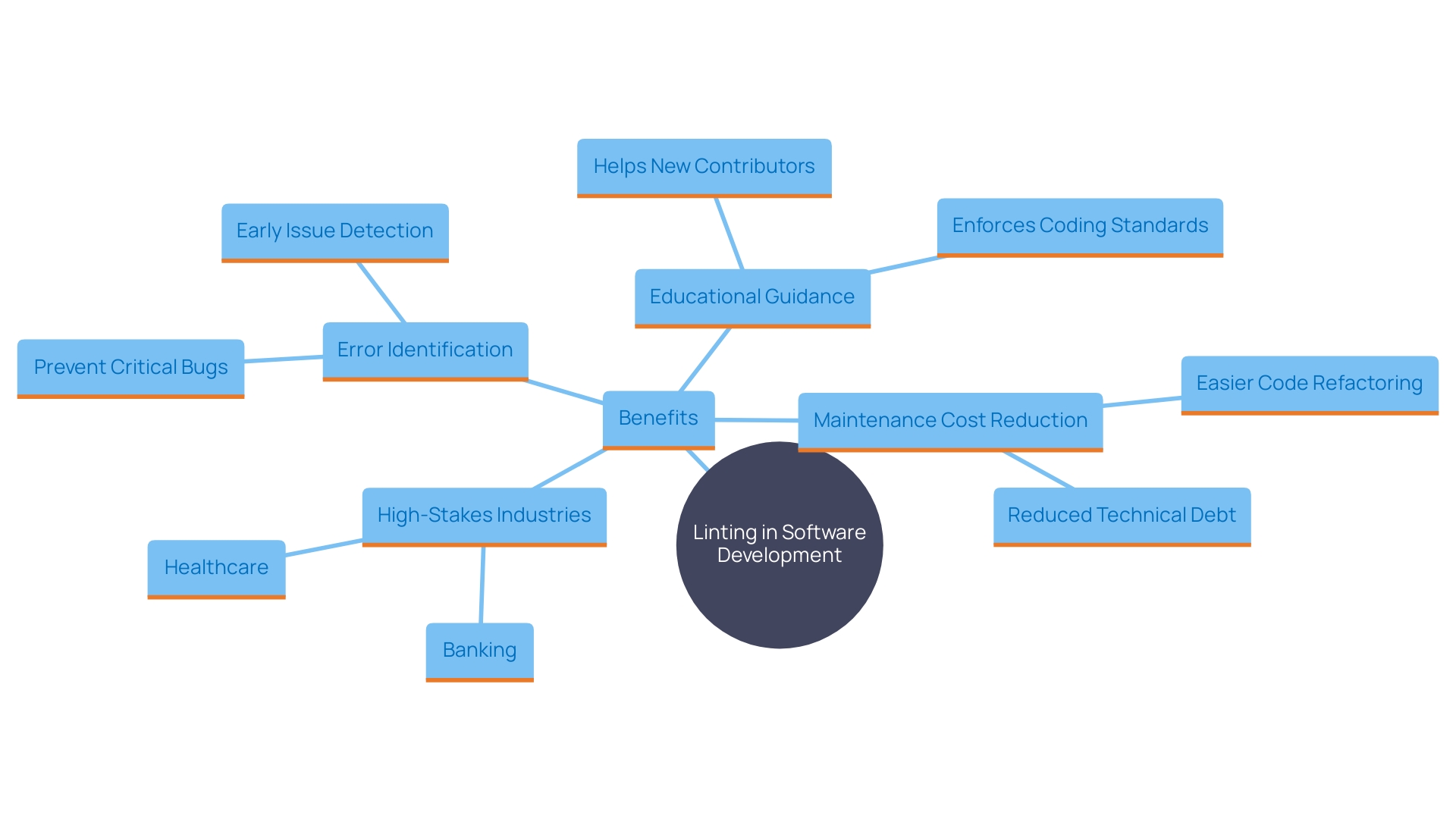Introduction
In the fast-paced world of software development, maintaining high code quality and consistency across teams can be a daunting challenge. Linting emerges as a crucial process, ensuring that code adheres to predefined standards and best practices. This automated analysis not only identifies potential errors and stylistic issues but also fosters an environment where clean, efficient, and maintainable code is the norm.
By integrating linting into the development workflow, teams can catch problems early, reduce debugging time, and enhance collaboration. This article delves into the history, benefits, and applications of linting tools, illustrating their indispensable role in modern programming and how they drive efficiency and productivity in software projects.
What is Linting?
Linting is an essential procedure in software development that entails the automated examination of programming to identify potential errors, stylistic issues, and other problematic patterns. This procedure assists developers in preserving high programming quality by enforcing coding norms and best practices. Linters provide real-time feedback, ensuring that the programming follows predefined guidelines, making it easier to read and maintain. By incorporating syntax checking utilities into the CI/CD process, teams can automatically uphold these standards, stopping non-compliant scripts from being merged. This standardization of programming practices is crucial, especially in large projects where multiple developers are involved, ensuring consistency and reducing the likelihood of bugs and security vulnerabilities. Furthermore, code analysis tools can assist developers on everything from spacing between lines to specific implementation details, thereby fostering a cohesive and efficient development environment.

History of Linting
The idea of error checking began in the late 1970s with a Unix tool named 'lint,' which was intended to examine C programming for possible mistakes. The name 'lint' was inspired by the small, often overlooked bits of fluff or fiber found in clothing, which can be seen as an analogy for the small, often overlooked errors in code. Over time, as programming languages evolved and new coding practices emerged, the concept of code analysis expanded to include various tools and approaches for different programming languages. Today, code analysis has become an essential part of the development workflow, helping programmers catch errors early in the coding process.
Linters can catch errors and potential bugs early, reducing the time spent on debugging later. By applying optimal methods and programming guidelines, syntax checking enhances the overall quality of the software, making it more durable and simpler to manage. For new contributors, particularly those not acquainted with the project's programming guidelines, linters act as an instructional resource, helping them to produce improved scripts.
Various programming languages possess their own linting resources. For instance, JavaScript developers may use ESLint, while Python programmers often rely on Pylint. These tools assist in guaranteeing that all contributors adhere to the same programming guidelines, enhancing the readability and consistency of the work. As Java technology continues to advance, it's the people, people like you, that give it such a strong heartbeat. So, with the holiday season upon us, I'd like to give thanks, appreciation, and recognition from Oracle's Java Developer Relations Team for many of those accomplishments and the people involved.
Benefits of Linting
Linting significantly enhances programming quality, reduces debugging time, and fosters collaboration among developers. By identifying errors and enforcing coding standards early, the process of code analysis minimizes the risk of bugs that could lead to costly fixes later in the development cycle. Consistent formatting and style guidelines improve readability and understanding across teams. As noted in a recent study, high Code Health metrics have a direct correlation with business value, showing that a healthy codebase can vastly reduce development time and defect rates. Linters serve as a powerful learning tool, guiding developers to write better, cleaner, and more efficient programs. The practice of linting aligns with the Agile principle of continuous attention to technical excellence and good design, ensuring that the programming remains robust and maintainable. A notable example is a team adopting a new coding guideline and using a linter to enforce it. At first, numerous problems were identified, but as programmers resolved them, their comprehension of the guidelines enhanced, resulting in neater programming and more effective development phases.

Linting Tools and Their Applications
Linting utilities are vital for upholding quality and consistency across different programming languages and frameworks. Tools like ESLint for JavaScript, Prettier for formatting, and RuboCop for Ruby are widely used to enforce coding standards and best practices. These resources can be smoothly incorporated into development settings like Visual Studio Code, allowing for automatic program evaluation and formatting as part of the development workflow. This not only guarantees early identification of mistakes and possible issues but also acts as a learning resource for new contributors, helping them to produce improved programming. Additionally, linting applications often come with customizable configurations, allowing teams to tailor the rules to their specific preferences and project requirements. By integrating these resources into your continuous integration and continuous deployment (CI/CD) workflow, you can guarantee that only compliant software is merged, thus upholding a high standard of quality throughout the project.

Importance of Linting in Programming
Linting is essential in today's software development environment, significantly improving quality and optimizing the programming process. By integrating linting tools, errors and potential bugs can be identified early, sharply reducing debugging time. This proactive approach not only ensures that the programming follows best practices but also maintains a clean and uniform codebase. For example, M&T Bank, a prominent U.S.-based commercial bank, encountered the challenge of creating clear programming guidelines across its development team. 'With the implementation of code analysis, they were able to minimize application maintenance time and costs, ensuring their software remained efficient, reliable, and secure against the backdrop of stringent regulatory requirements.'. Linting tools serve as educational guides for new contributors, promoting consistent coding standards and making the code more robust and easier to maintain. Such measures are crucial in industries like banking, where introducing software problems can lead to catastrophic security breaches and financial losses. Ultimately, linting transforms development workflows, driving efficiency and productivity by keeping codebases clean and maintainable.

Conclusion
In the fast-paced realm of software development, linting is crucial for enhancing code quality and optimizing workflows. By automating code analysis, linting tools quickly identify errors and enforce coding standards, which significantly cuts down debugging time and promotes maintainable code.
Originating from the Unix utility 'lint' in the late 1970s, the concept has evolved to include various tools for different programming languages. These tools not only improve code readability and consistency but also serve as educational resources for developers, guiding them toward best practices.
The benefits of linting extend beyond error detection; they foster collaboration by ensuring all team members follow shared coding guidelines, resulting in a healthier codebase. This consistency can lead to reduced maintenance costs and improved software reliability.
In summary, integrating linting into the development workflow is essential. By embracing this practice, teams can maintain high-quality code, minimize bugs, and enhance overall productivity. As software projects become increasingly complex, the role of linting in sustaining clean and efficient codebases is more vital than ever.
Frequently Asked Questions
What is linting?
Linting is an automated process used in software development to examine programming code for potential errors, stylistic issues, and other problematic patterns. It helps maintain high programming quality by enforcing coding norms and best practices.
Why is linting important?
Linting is important because it ensures code quality, reduces the time spent on debugging, and fosters collaboration among developers. By identifying issues early, it minimizes the risk of bugs that could lead to costly fixes later in the development cycle.
How do linters provide feedback?
Linters provide real-time feedback by checking code against predefined guidelines. This makes it easier for developers to write readable and maintainable code, as they can correct issues as they arise.
How has the concept of linting evolved?
The idea of error checking began in the late 1970s with a Unix tool called 'lint,' which was used to examine C programming for mistakes. Over the years, linting has expanded to include various tools for different programming languages, adapting to new coding practices.
What are some common linting tools?
Common linting tools include ESLint for JavaScript, Pylint for Python, and RuboCop for Ruby. These tools help ensure all contributors adhere to the same programming guidelines, improving code readability and consistency.
How does linting benefit new contributors?
Linting acts as an instructional resource for new contributors, helping them understand and follow the project's programming guidelines. This support encourages them to write better and cleaner code.
How does linting integrate into the development workflow?
Linting tools can be integrated into development environments like Visual Studio Code, allowing for automatic code evaluation and formatting. By incorporating linting into continuous integration and continuous deployment (CI/CD) workflows, teams can ensure that only compliant code is merged.
What impact does linting have on the software development process?
Linting transforms development workflows by driving efficiency and productivity. It helps maintain a clean and uniform codebase, reducing maintenance time and costs, especially in industries where software issues can lead to significant risks, such as banking.
Can linting tools be customized?
Yes, linting applications often come with customizable configurations that allow teams to tailor the rules to their specific project requirements and preferences.
What is the overall significance of linting in programming?
Linting significantly enhances code quality, reduces debugging time, and promotes consistent coding standards. This practice aligns with the Agile principle of continuous attention to technical excellence, ensuring that programming remains robust and maintainable.




